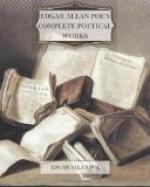About the middle of the poem, also, I have availed myself of the force of contrast, with a view of deepening the ultimate impression. For example, an air of the fantastic—approaching as nearly to the ludicrous as was admissible—is given to the Raven’s entrance. He comes in “with many a flirt and flutter.”
Not the least obeisance made he—not
a moment stopped or stayed he,
But with mien of lord or lady,
perched above my chamber door.
In the two stanzas which follow, the design is more obviously carried out:
Then this ebony bird beguiling my sad
fancy into smiling
By the grave and stern decorum of the
countenance it wore,
“Though thy crest be shorn and
shaven, thou,” I said, “art sure no
craven,
Ghastly grim and ancient Raven wandering
from the nightly shore—
Tell me what thy lordly name is on the
night’s Plutonian shore?”
Quoth the Raven,
“Nevermore.”
Much I marvelled this ungainly fowl
to hear discourse so plainly,
Though its answer little meaning—little
relevancy bore;
For we cannot help agreeing that no living
human being
Ever yet was blessed with seeing bird
above his chamber door—
Bird or beast upon the sculptured bust
above his chamber door,
With such name
as “Nevermore.”
The effect of the denouement being thus provided for, I immediately drop the fantastic for a tone of the most profound seriousness—this tone commencing in the stanza directly following the one last quoted, with the line,
But the Raven, sitting lonely on that placid bust, spoke only, etc.
From this epoch the lover no longer jests—no longer sees anything even of the fantastic in the Raven’s demeanor. He speaks of him as a “grim, ungainly, ghastly, gaunt, and ominous bird of yore,” and feels the “fiery eyes” burning into his “bosom’s core.” This revolution of thought, or fancy, on the lover’s part, is intended to induce a similar one on the part of the reader—to bring the mind into a proper frame for the denouement—which is now brought about as rapidly and as directly as possible.
With the denouement proper—with the Raven’s reply, “Nevermore,” to the lover’s final demand if he shall meet his mistress in another world—the poem, in its obvious phase, that of a simple narrative, may be said to have its completion. So far, everything is within the limits of the accountable—of the real. A raven having learned by rote the single word “Nevermore,” and having escaped from the custody of its owner, is driven at midnight, through the violence of a storm, to seek admission at a window from which a light still gleams—the chamber-window of a student, occupied half in pouring over a volume, half in dreaming of a beloved mistress deceased. The casement being thrown open at the fluttering of the bird’s wings, the bird itself




